| Doctor Who | Non-valid sources | Appearances | Talk |
- You may wish to consult
Doctor Who (disambiguation)for other, similarly-named pages.
Doctor Who was a television series produced by the BBC in the 1960s, centring around the eponymous character known as, among other names, the Doctor. The television series eventually had many novels, CDs, and merchandise that formed part of its large multi-media franchise. (PROSE: The Terror of the Umpty Ums, A Letter from the Doctor, etc.)
Generally, it was considered by its viewers to be a work of fiction, (PROSE: The Terror of the Umpty Ums, A Letter from the Doctor, etc.) though those who produced the stories often had a history with the Doctor and thus based their stories upon the Doctor's adventures. (PROSE: Stop, Thief!, Bafflement and Devotion, etc.) The Doctor themself, on numerous occasions, appeared in person to endorse and promote the series, (PROSE: A Letter from the Doctor, TV: Untitled, The Doctor Drops In, The Doctor Appears) with some accounts positing that the series itself was a documentation of the Doctor's adventures, (COMIC: Dalek Invasion of Earth 2150 B.C., PROSE: Dalek Survival Guide) or that the Doctor, at the least, portrayed themself on-screen. (COMIC: TV Terrors) While one account claimed the programme was largely fictional, many of the stories were based upon real occurrences. (PROSE: Background)
History[]
In the 19th century[]
The Fourth Doctor once wrote and dispatched two letters at a post office on Ganymede on 42 Paztenmber, relative to 1845 "Earth-time", as the Doctor wanted to ensure his letters arrived in time to be printed in the first issue of Doctor Who Weekly. In the first letter, the Doctor talked about several features in the magazine, and in the second letter, the Doctor explained how to use the rub-down action transfers on two colour panoramas illustrated by Dave Gibbons. (PROSE: A Letter from the Doctor)
In the 20th century[]
Development[]
The creation of the series by the BBC was spurred by the growing appetite of the British public for realistic science fiction, which had ironically been whetted by the accidental broadcasting in 1953 of real footage of the head of the British Rocket Group fighting off an extraterrestrial creature, which the Home Secretary had hurriedly passed off as fiction. (PROSE: Background)
Indeed, it had been Winston Churchill who suggested in a letter to Mr Newman that he should alter his "whole new type of drama" to be based upon the story of Churchill's old friend, the Doctor, during production on 26 March 1963. (PROSE: Stop, Thief!)
According to the Dalek Survival Guide, Doctor Who was a documentary series which was devised to alert the general public to the various alien dangers they faced, while at the same time serving as a dramatised biography of the central character, the Doctor. (PROSE: Dalek Survival Guide)
November 1963[]
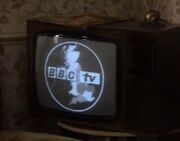
The series on Mrs Smith's television. (TV: Remembrance of the Daleks)
A BBC science fiction series beginning Doc- was first broadcast on television at 5:15 pm on Saturday (TV: Remembrance of the Daleks) 30th of November, 1963. (PROSE: Who Killed Kennedy)
Early on, there was a novel called Doctor Who in an Exciting Adventure with the Daleks, which, according to the Eighth Doctor, contradicted another book, Doctor Who and an Unearthly Child. (PROSE: Bafflement and Devotion) This book was later illicitly shared around on Gallifrey during the War, albeit with its title partially censored for security reasons. (PROSE: The Taking of Planet 5)

The children watch Dr. Who. (COMIC: TV Terrors)
Sometime in the mid-1960s, Monica, Buttons, and Cuthbert tried to get Dr. Who's autograph after seeing him on television, but after they arrived at the studio and chased by the studio guard, they took refuge in Dr. Who's TARDIS that had been "parked" outside the studio. Buttons pressed a button, causing the TARDIS to take them to the Stone Age, which they spent little time exploring due to a caveman chasing them for trying to access a Stone Age TV Studio. After they returned to the 20th century, they left the TARDIS, and were chased by the guard once again. (COMIC: TV Terrors)
1970s[]
Sometime in the 1970s, Terrance Dicks listened in on a conversation between the Third Doctor, Jo, the Brigadier, and a Doctor Who fan from the future, who was asking UNIT for help regarding COVID-19. He would join in on the conversation a few minutes later, where he came up with a name for a Doctor Who story, "who's for a brew". He wrote it down, intending to share it with Barry, before disconnecting from the call. (WC: U.N.I.T. On Call)
In 1971, the serial The Claws of Axos aired. There was, at least according to Claudia Winkleman in 2013, an "alien duplication unit" present in the story. (TV: The Doctor Appears)
In 1974, a serial of the series aired, portraying the regeneration of the Third Doctor into his next incarnation, the Fourth Doctor. (PROSE: Fanboys) The Fourth Doctor was played by Tom Baker, and was Paul Magrs' favourite actor to portray the Doctor. (PROSE: The Story of Fester Cat)
On Christmas, 1977, eight-year old Paul received a Doctor Who jigsaw, which had a picture of Tom Baker on it. (PROSE: The Story of Fester Cat)
In 1978, Iris Wildthyme was sent by the Ministry to investigate Geoff Love as the Ministry suspected him of secreting in subliminal messages into his reworkings of classic TV sci-fi themes. Iris helped Geoff develop a remixed Doctor Who theme while proving that the Ministry was indeed correct with their suspicions. (PROSE: Bafflement and Devotion)
On Christmas, 1979, Paul was given a Dr Who Paint-by-Numbers kit. (PROSE: Party Like it's 1979)
1980s[]
Prior to 1981, serials known as The Seeds of Doom, State of Decay and Planet of the Spiders were broadcast, the latter of which depicting the Fourth Doctor's regeneration into the Fifth Doctor, who was set to return in the following season. By this time, the Wirrn, Zarbi, Sontarans, Krynoids, Zygons, Mechanoids, Yeti, and the Brain of Morbius all had been featured in the show, serving the role of the villains.
In early 1981, David and Chris were major fans of the series. They obsessed over the series and went to Darlington on a semi-regular basis, where they would be treated by their parents by taking them into WHSmith's to buy Target novelisations of Doctor Who stories. On one such occasion, they bought copies of State of Decay and Planet of the Spiders. (PROSE: Fanboys)
K9 and Company premiered around Christmas 1981. (PROSE: The Story of Fester Cat)
After the Sixth Doctor finished telling the audience that they had been watching Roland Rat: The Series, and that they should now switch over to BBC1's Doctor Who, Reggie Rat jumped up, shouting that Doctor Who was "rubbish", which caused the Sixth Doctor to promptly attempt to murder the rat. (TV: Untitled)
According to an American correspondent, Jay Eales had been responsible for the cancellation of Doctor Who in 1989 after he "fiendishly" edited a charity fanthology, Walking in Eternity, in the year 2000. (PROSE: Contributors)
UNIT era[]
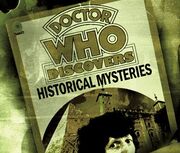
Doctor Who Discovers Historical Mysteries. (AUDIO: The Kingmaker)
According to one account, the Doctor Who brand came about by accident after the press's awareness of the Doctor turned him into a reluctant celebrity, the Fifth Doctor suggesting that the newfound exposure came following the Fourth Doctor's encounter with the Loch Ness Monster. A publisher approached the Doctor, who accepted their request to write factual books aimed at children. The resulting series was intended to be named The Doctor, Who Discovers but became Doctor Who Discovers after "some idiot" in the publisher's design department missed the "The". The Doctor completed five books in the series and began work on the sixth, Doctor Who Discovers Historical Mysteries, but left it unfinished until a robot sent by the publishers from the 64th century invaded the TARDIS to forcefully remind him of his contractual obligation. (AUDIO: The Kingmaker)
Another account stated a sixth book was indeed created during this time, titled Doctor Who Discovers Pirates. (PROSE: Doctor Who Discovers Pirates)
1990s[]
In the late 1990s, an unspecified incarnation of the character was portrayed by Paul McGann in the Doctor Who TV movie. (PROSE: Hospitality)
In the 21st century[]
2000s[]
Published around the turn of the 21st century, the Dalek Survival Guide acknowledged Doctor Who as a series of dramatised biographies transmitted as family entertainment between 1963 and 1996. The series was followed by various published biographies presented in "mock-fictional" form as segments of the Doctor's lives; some of these biographies were, according to the guide, "of dubious provenance". (PROSE: Dalek Survival Guide)
Around the early 2000s, Paul Magrs wrote in a short piece of prose about his books and inspirations. In this piece, he stated that the second and fourth incarnations of the Doctor were Patrick Troughton and Tom Baker, respectively, and that his collection of all 150 Target novels written by Terrance Dicks had been stolen. (PROSE: Bafflement and Devotion)
In SpoilerSpace, Raf told his assistant to tell any Doctor Who fans wanting to purchase the latest book that they'd have to wait due to a late delivery. She thought that Doctor Who fans were the worst, but Raf disagreed. (PROSE: To the Devil — a Diva!)
In the mid-2000s, billboard advertisements were placed around Cardiff for the Doctor Who Exhibition. (TV: Everything Changes)

Various Doctor Who annuals stacked on tables and placed on shelves in Books UnLtd. (COMIC: A Groatsworth of Wit)
By 2006, Books UnLtd stocked Doctor Who annuals, which Robert Greene walked past as he entered the shop. (COMIC: A Groatsworth of Wit)
By the 21st century, Cybermen, Weeping Angels, Sontarans and Slitheen had appeared in the franchise. David Karpagnon, an orphan with dissociative personality disorder, watched the show around this time. The Doctor helped him with his problems from inside his head. (PROSE: The Terror of the Umpty Ums)
In 2008, Paul Magrs worked on several scripts for Doctor Who CDs, which, once completed, would require Paul to travel to London and help with the production, where he got to meet Tom Baker. (PROSE: The Story of Fester Cat)
2010s[]
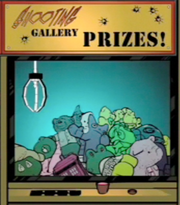
The plush TARDIS prize within a claw machine. (WC: Web of Lies)
In the early 2010s, Matt Smith was an actor in the series. (TV: The Doctor Drops In, The Doctor Appears)
In 2011, there was a pink TARDIS as a prize in a claw machine in a fairground on Coney Island. (WC: Web of Lies)
In a Wackopedia article about the partially lost David Bowie album Low/Profile dated to September 2012, last updated by George Mann, Doctor Who, Dad's Army, and Callan were listed as examples of television shows that had deleted content. (PROSE: Low/Profile)
On Red Nose Day 2013, Dermot O'Leary surprised his co-presenter Claudia Winkleman with a guest appearance of the Eleventh Doctor. At the event, an episode of Doctor Who played on screen behind them with an actor portraying Walter Simeon, and Claudia flirtatiously chased the Doctor around. (TV: The Doctor Appears) Later that year, The Day of the Doctor was broadcast in 3D. (TV: The Doctor Appears, WC: The Zygon Isolation)
Peter Capaldi was cast as the Twelfth Doctor in 2013, where he attended a meeting with Steven Moffat. Capaldi prepared for this meeting by reading issues of DWM. Later, he wrote a letter to the readers of DWM, writing about his more than positive opinions of the magazine. (PROSE: A Letter from the Doctor 464)
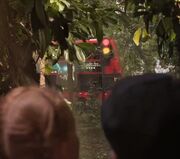
A poster on a double decker bus in 2014. (TV: In the Forest of the Night)
In November 2014, (PROSE: "Assessing the Risk") when the Earth became overgrown with trees, a double decker bus had an advertisement on its side, depicting the TARDIS and individuals closely resembling the Twelfth Doctor and Clara Oswald. An unknown source rated the show four stars out of five commenting "A-MAZE-ING ENTERTAINMENT!". (TV: In the Forest of the Night)
Around October of 2015, the ninth series of the show was broadcast on BBC One, comprising of the stories New Series Prologue, The Magician's Apprentice, The Witch's Familiar, Under the Lake, Before the Flood, The Girl Who Died, The Woman Who Lived, The Zygon Invasion, The Zygon Inversion, Sleep No More, Face the Raven, and Heaven Sent. (WC: The Zygon Isolation)
On 29 April 2016, Peter Capaldi was asked by Doctor Who Magazine to write a letter for the five-hundredth issue. He had written another letter for the magazine a while back, but couldn't remember if it was for the one-thousandth or the one hundred-thousandth issue. In his letter, he noted that the magazine had a comic strip, and he was proud to have his likeness be captured so well, as well as how inspirational the magazine was to its fans. (PROSE: A Letter from the Doctor 500)
Colin Baker was once put on trial for not paying a parking fine, which he received whilst filming ten hours of new content for Doctor Who Season 23, which included updated special effects and extended versions of every episode, as well as behind the scenes material such as The Writers' Room: The Missing Season 23?, The Doctor Who Cookbook Revisited, and The Doctor's Table: Season 23. Despite showing the magistrate evidence of this on his iPad which had been beamed directly from the Matrix, he was "put away" in a cell with his friend Nicola Bryant, who had been put there for marrying Brian Blessed. (WC: The Trial)
2020s[]

Osgood's desktop. (WC: The Zygon Isolation)
In her garden, Louise Jameson spoke to her friend Tom about how wonderful her new Home Assistant V14 was. During the phone call, she gave it too many orders, causing the robot malfunctioned and attempt to kill her. Hanging up on Tom, Louise grabbed a Doctor Who Season 14 boxset and used it to knock the Home Assistant to the ground, deactivating it. (WC: Home Assistant)
By 2020, the show had 12 series and 167 episodes that were available on BBC iPlayer. (WC: The Zygon Isolation)
On 10 May, 2020, the two Osgoods conversed over Zoom. Afterwards, one of the duo went onto BBC iPlayer after ending the chat, scrolling past several episodes of Doctor Who from series nine, until she decided to watch The Zygon Invasion. (WC: The Zygon Isolation)
In late 2020, after a fan finished watching an episode, she rang UNIT in the 1970s, asking for help from the real Third Doctor, Jo, and the Brigadier, and they told her to remain positive despite the hardships. Terrance Dicks, also on the call, applauded the trio and told the fan a tea break was deserved. He then came up with an idea for the name of a story. After the call, the fan drank a cup of tea while watching an older episode of Doctor Who. (WC: U.N.I.T. On Call)
2060s[]
By 2065, (PROSE: Peaceful Thals Ambushed!) William Hartnell had played the part of "Dr. Who" in "the television series". However, he was too busy to play the character in the film adaption Dr. Who and the Daleks, leaving Peter Cushing to take on the role. (PROSE: Lady Penelope Investigates the stars of the Sensational new film Dr. Who and the Daleks!) Other accounts held that Hartnell and Cushing had lived much earlier in human history, the 20th century, (AUDIO: Pier Pressure; COMIC: Whodunnit?; PROSE: From Wildthyme with Love, et. al) but the real Doctor had met both men. (AUDIO: Pier Pressure; PROSE: The Day of the Doctor) In fact, the Doctor was known to have taken Cushing throughout time, allowing the actor to appear in films made after his death. (PROSE: The Day of the Doctor)
By 2067, there was a BBC series one account called "F[REDACTED] P[REDACTED]" that featured an actor take on the role of Auteur. This actor, whose name was redacted like the show's name, continued to hold the role up to 7898. (PROSE: Auteur's Abecedarium) However, actor David Bradly instead played Auteur in the 200th Anniversary Special by wearing a rubber mask. (PROSE: Resurrection of the Author) The redacted title featuring an "F" and a "P" in front of each word, (PROSE: Auteur's Abecedarium) matched the name of the rogue Great House of Faction Paradox, (PROSE: The Book of the War) of which Auteur was a member. (PROSE: A Bloody (And Public) Domaine, Going Once, Going Twice)
In the 26th century[]
2590s[]
In 2596, Chris Cwej and Clarence once watched a show on a vidscreen that ran for "thirty-odd years" and mostly comprised of "people being captured and escaping, a lot of running and an explosion at the end". Clarence found this series to be predictable, but they both preferred it to the alternative, which were cookery shows. (PROSE: Twilight of the Gods)
Cwej was actually a native of the 30th century (PROSE: Head Games) and had grown up on another series, EarthDoom XV. This holovid series told a fictionalised version of the Third Dalek War with a low budget. Nonetheless, it scared the young Cwej and others his age. (PROSE: Sky Pirates!)
Undated events[]
A narrator once told the story of the Mechonoid Incident, warning that it was a real despite how fantastical it was. (AUDIO: The Daleks)
David Fisher wrote the story The Stones of Blood, a story which involved a stone circle. (PROSE: The Stones of Spookiness)
Justin Richards was the author of many stories about the Doctor. (PROSE: Summer Falls and Other Stories)
Kelly Hale once co-authored a Doctor Who tie-in novel and another novel, Erasing Sherlock. (PROSE: Contributors)

In Melanie Bush's spacestation headquarters, the Seventh Doctor gave Mel a copy of Doctor Who The Collection Season 24, which he claimed was a "holographic, six-dimensional record" of his and Mel's adventures. They decided to watch an episode, but not the one with the Tetraps. (WC: 24 Carat)
Gallifrey: a rough guide, when suggesting leisurely activities for time-active vacationers to partake in on their trip to Gallifrey, illustrated the many uses of its Matrix by suggesting the option to view the various title sequences of Doctor Who. (PROSE: Gallifrey: A Rough Guide)
Jo Grant once used a Doctor Who stamp on her space-time postcard to Mike Yates. (PROSE: Greyhound)
Other accounts[]
Info about The Time Surgeon, Doctor X, Professor X, Doctor Omega, Doctor, Mister E, and Comic Relief spectacular needs to be added.
Other accounts of the Doctor appearing in Earth fiction, sometimes as a character called "Doctor Who", suggested that some of the movies and TV programmes about the character were based on records and testimonies of the real Doctor. (PROSE: Stop, Thief!, Salvation, The Day of the Doctor) It has been suggested that when the Doctor's existence has become too noticeable to a world, they have a favourite "panic button", going back in time and introducing themselves as a fictional character in that world's mythology. (PROSE: Afterword)
Premiering in the 1950s, (PROSE: In Search of Doctor X) the television series Doctor X shared similarities Doctor Who, (PROSE: In Search of Doctor X, WC: Doctor X, etc.) with the series both being primarily science fiction, centring around a mysterious, eponymous time traveller, with similarly named books[1], (PROSE: In Search of Doctor X, Bafflement and Devotion) as well as a dedicated fanbase. (PROSE: Bafflement and Devotion, The Story of Fester Cat, WC: Doctor X)
Parallel timelines[]
- Main article: Meta-fiction universe
Doctor Who also existed as a TV series/franchise in several parallel universes. (COMIC: TV Action!, The Girl Who Loved Doctor Who, PROSE: All Our Christmases, The Thief of Sherwood, AUDIO: Deadline)
Behind the scenes[]
History of the concept[]
The existence of the TV series Doctor Who within the Doctor Who universe is a metafictional gimmick with a long and storied history within licensed Doctor Who fiction. The show itself stopped just shy of confirming the existence of a series called Doctor Who within its universe on two occasions; the first was in Remembrance of the Daleks, where a TV series whose title began with "Doc…", and which debuted on the same date as the real-life Doctor Who, was briefly mentioned — only for the characters (and viewers) to miss the full name of the programme. Many years later, a poster featuring the Twelfth Doctor, Clara Oswald and the Doctor's TARDIS was glimpsed in the background of the Series 8 episode In the Forest of the Night, but with no title visible.
The ArcHive Tapes established the Earth Documents, a series of audio-visual documents which were essentially in-universe recordings of the Doctor's adventures, as a rationale to utilise archive audio from Doctor Who.
As a significant part of popular culture of Earth history in their own universe, television programmes and books based upon the Doctor have also been referenced in other in-universe sources; some, like Sarah Jane Smith's Doctor series, were reminiscent but distinct from real-life Doctor Who productions, while others, such as the mention of the two Peter Cushing movies in Steven Moffat's Day of the Doctor novelisation, intentionally matched pieces of real-life Doctor Who fiction. While many stories about the in-universe series failed to address how it could exist within the Doctor's universe (with stories such as PROSE: A Letter from the Doctor and TV: The Doctor Drops In and The Doctor Appears coming close, depicting the Doctor endorsing the series), only the short story Background actually addressed the issues, to some extent, positing that the series was created by the BBC after being inspired by an incident in 1953 where they had caught footage of an alien organism (which had subsequently been broadcast on television), causing the Home Secretary to issue a public statement that the footage was actual from a science fiction programme. Doctor Who was a culmination of the public's desire for science fiction during the following decades, and such, the BBC created the series, mostly as fiction, with certain stories being based upon actual events.
As an in-universe concept, Doctor Who has been additionally used in parallel universes — where the logically thorny implications of the series known to the viewer simultaneously being a true account of a time-traveller's life, and a piece of fiction which the same individual could theoretically watch, would be lessened. The Eighth Doctor discovered the existence of Doctor Who in TV Action! while the Eleventh Doctor dealt with chapters of his life being chronicled as episodes of a television programme in The Girl Who Loved Doctor Who. The articles from The Thief of Sherwood, which depict an adventure with the First Doctor, Susan, Ian and Barbara where they meet Robin Hood, is placed in "an alternate version of our world", belonging to the Doctor's multiverse, by authorial intent.
Other notes[]
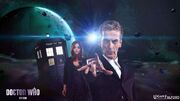
The fan-made poster used on the bus in In the Forest of the Night.
The bus seen in In the Forest of the Night was cardboard, as it was too hard to transport a real bus into the forest. The advert seen on the bus was a fan-made poster for series 8 of Doctor Who, made by Logan Fulford.
The Doctor Who annuals seen in COMIC: A Groatsworth of Wit, while are clearly recognisable, the specific years are too small to make out. In the real world, these annuals correspond to the 1968 and 2006 annuals.
In some stories, vague allusions towards Doctor Who stories have been made, such as in PROSE: I Am the Doctor, where Nardole watches "The Chase"; whether this was a meta-fictional reference to the Doctor Who serial or a reference to the game-show of the same name is currently unclear. Similar instances have occurred with characters, where they've been named after or in homage to real world individuals involved with Doctor Who, with ambiguity surrounding whether they're supposed to be direct, in-universe counterparts, equivalents of, or even entirely unrelated individuals in all but name.
Many of Douglas Adams' Doctor Who stories, such as TV: Destiny of the Daleks and TV: Shada, have implied a shared universe with The Hitchhiker's Guide to the Galaxy series, however an authorised sequel And Another Thing... seems to contradict this by having Arthur Dent compare the destruction of Earth to early special effects on Doctor Who, however by the content gathered on this page, this disparity can be easily reconciled.
Information from invalid sources[]
Dead Ringers[]
In a Dead Ringers sketch, the Tenth Doctor, whilst spending Christmas with his previous incarnations, suggested that they put the television as he "heard there might be something good on" only for the other Doctors to reject him, with the Ninth Doctor saying that he does not want to watch the "poncy Doctor".
Ident Interruptions[]
During the run up to the broadcast of The Day of the Doctor, the Eleventh Doctor interrupted idents on BBC One. (NOTVALID: Eleventh Doctor Ident Interruptions)
During the run up to the broadcast of Series 8, the Twelfth Doctor interrupted idents on BBC One. (NOTVALID: Twelfth Doctor Ident Interruptions)
Oh Mummy![]
When Sutekh auditioned for the role of himself, Philip Hinchcliffe set fire to many objects to see if Sutekh could hold back the flames. Unbeknownst to him at the time, one of these objects was a copy of Fury from the Deep. (NOTVALID: Oh Mummy!)
Eye on... Blatchford[]

Sardoth's DVD copy of Fury from the Deep. (NOTVALID: Eye on... Blatchford)
In his home, Sardoth read The Dr Who Annual 1979, and in his attic, had a DVD copy of Fury from the Deep in a cardboard box. (NOTVALID: Eye on... Blatchford)
Doctor Who meets Mr. Men[]

An episode of Doctor Who on a TV. (NOTVALID: Doctor Who meets Mr. Men)
Doctor Who was the favourite TV show of Little Miss Dee, who watched it with her friends. After watching an "exciting episode" of the series, she heard the TARDIS materialising and searched for it. After verifying that it hadn't materialised in the Weeping Angel graveyard, Zygon cave, or Cybermen spaceship, she used a vortex manipulator to appear in Adam Hargreaves' studio, where he talked about combining Doctor Who with Mr. Men. The "Doctor Who Roger Hargreaves books" included Dr. First, Dr. Fourth, Dr. Eleventh, and Dr. Twelfth. (NOTVALID: Doctor Who meets Mr. Men)
Peter Capaldi and Simon the Shy Cyberman Invite You to Breakfast with 7 Doctors[]
The Doctor first learned of the series through, in the Twelfth Doctor's words, "various psychic shenanigans". When the various actors who had played the Doctor came together for a special breakfast event, the Twelfth Doctor considered going to it, telling Simon the Shy Cyberman and another individual as such. (WC: Peter Capaldi and Simon the Shy Cyberman Invite You to Breakfast with 7 Doctors)
Verity[]
A young woman, Verity, went to the BBC, and became the producer of the show, despite the protests of the "Men Who Knew What To Do". By standing her ground against their blatant sexism, she helped the Doctor Who series flourish with her creative ideas.
Early on in the series, there were Cavemen, Daleks, Aztecs and Marco Polo. (NOTVALID: Verity)
A New Year's message from the Doctor[]
The Thirteenth Doctor and everybody at Doctor Who once wished their audience "love and luck" for 2021. (NOTVALID: A New Year's message from the Doctor...)
Tom Baker stars in John Lloyd's lost Doctor Who adventure, The Doomsday Contract[]
In 1978, Douglas Adams became the script editor for Doctor Who after he finished writing The Hitchhiker's Guide to the Galaxy for Radio 4. John Lloyd, who had assisted Adams with the writing for Hitchhiker's, submitted a story treatment entitled The Doomsday Contract. Despite putting a lot of work into multiple drafts, the episode was never produced and Lloyd moved onto other projects.
In 2021, Big Finish produced a "full cast audio version" of the unproduced serial The Doomsday Contract, written by John Lloyd and Nev Fountain, starring Tom Baker, Lalla Ward, John Leeson, and Julian Wadham. (NOTVALID: Tom Baker stars in John Lloyd's lost Doctor Who adventure, The Doomsday Contract)
External links[]
Footnotes[]
| |||||||||||||||||||||||||||||||||||||||||||||||||||||||||||||||||||||||||||||||||||||||||||||||||||||||||||||||||||||||||||||||||||||||||||||||||||||||||||||||||||||||||||||||||||||||||||||||||||||||||||||||||||||||||||||||||||||||||||||||||||||||||||||||||||||||||||||||||||||||||||||||||||||||||||||||||||||||||||||||||||||||||||||||||||||||||||||
| |||||||||||||||||||||||||||||||||||||||||||||||||||||||||||||||
